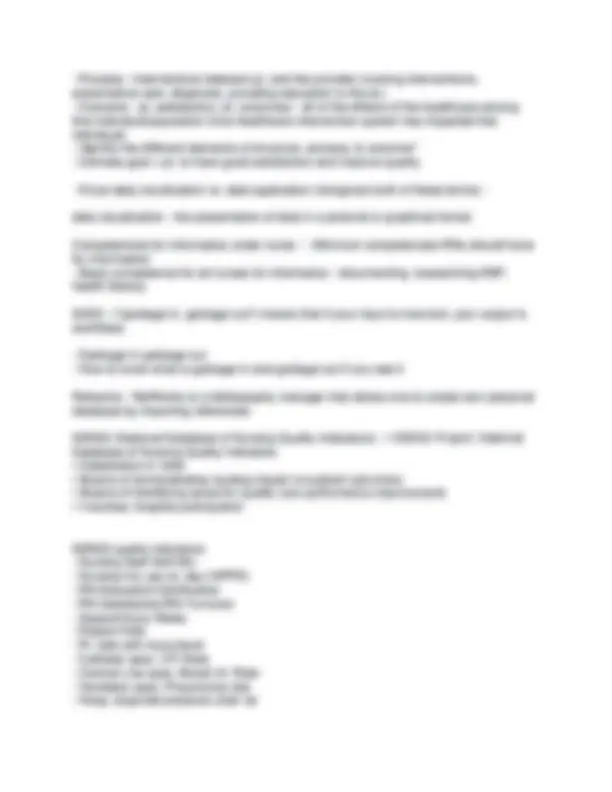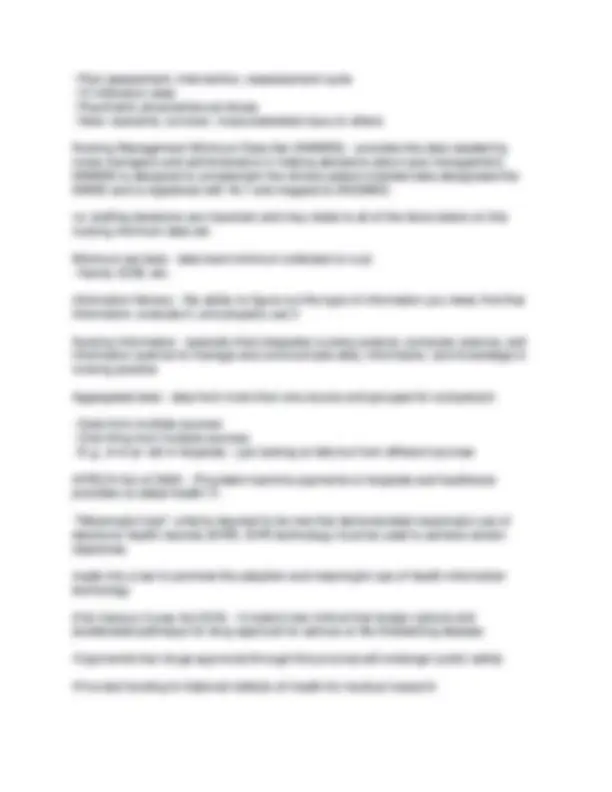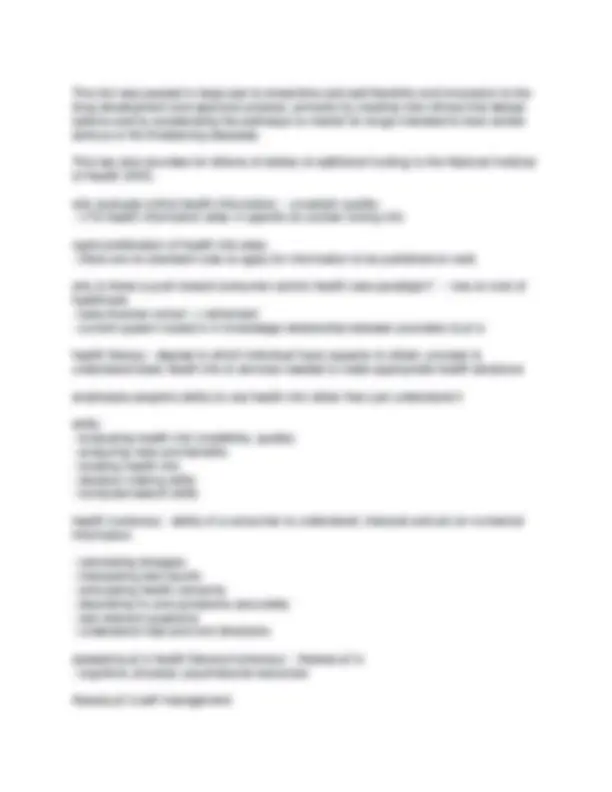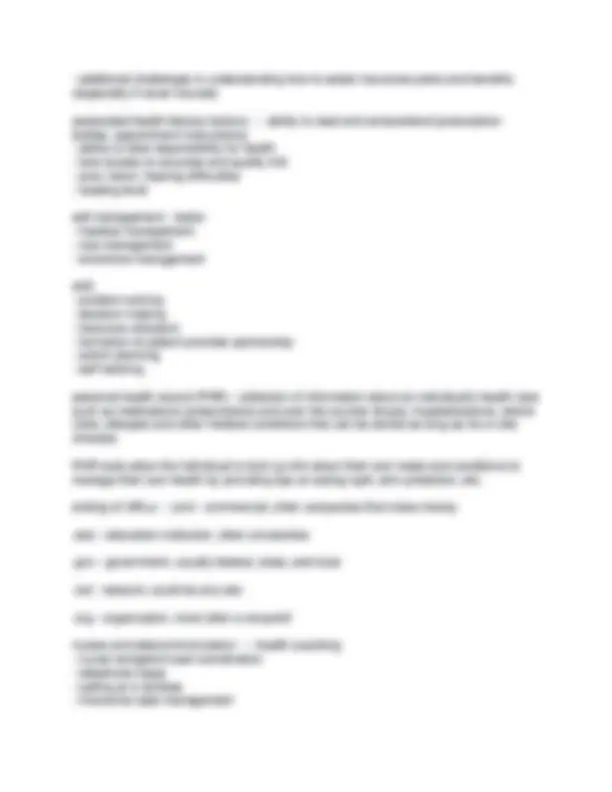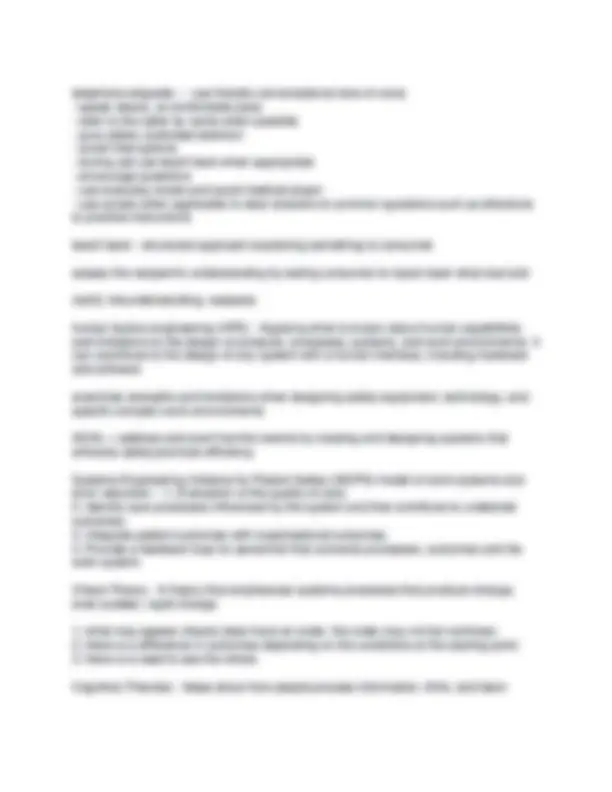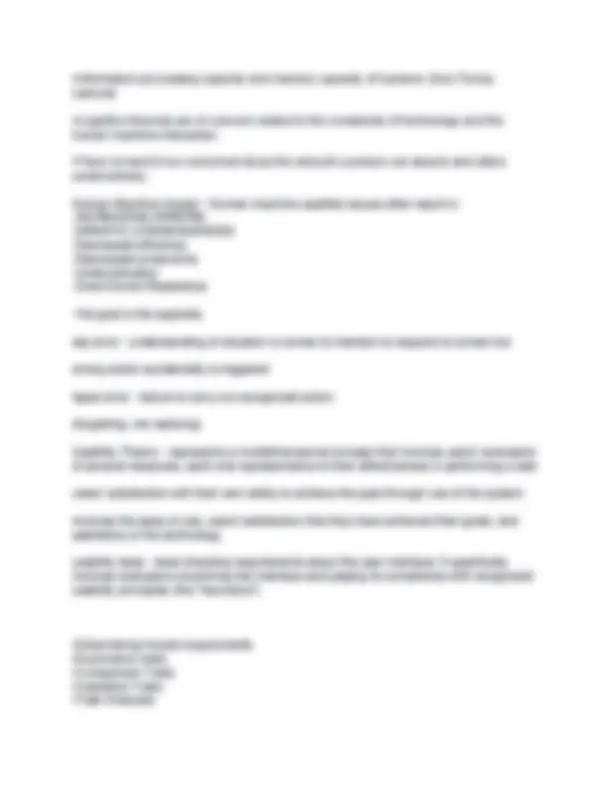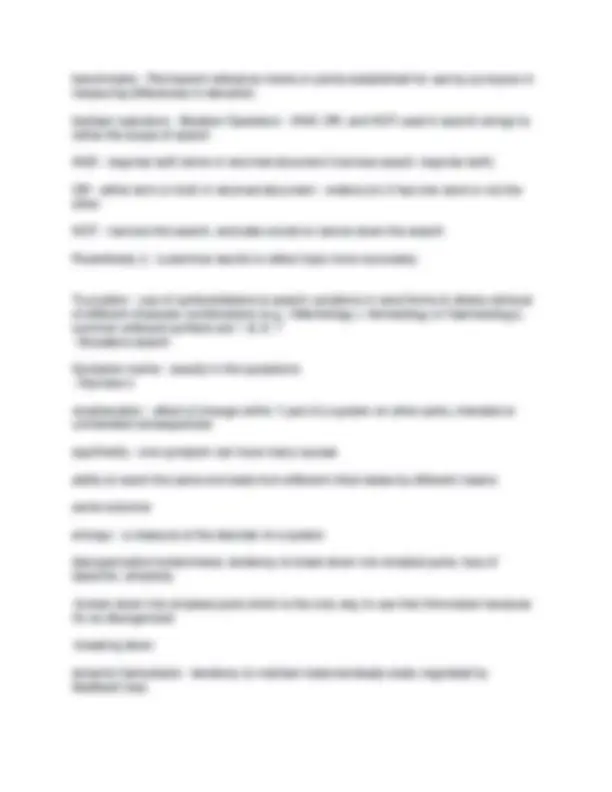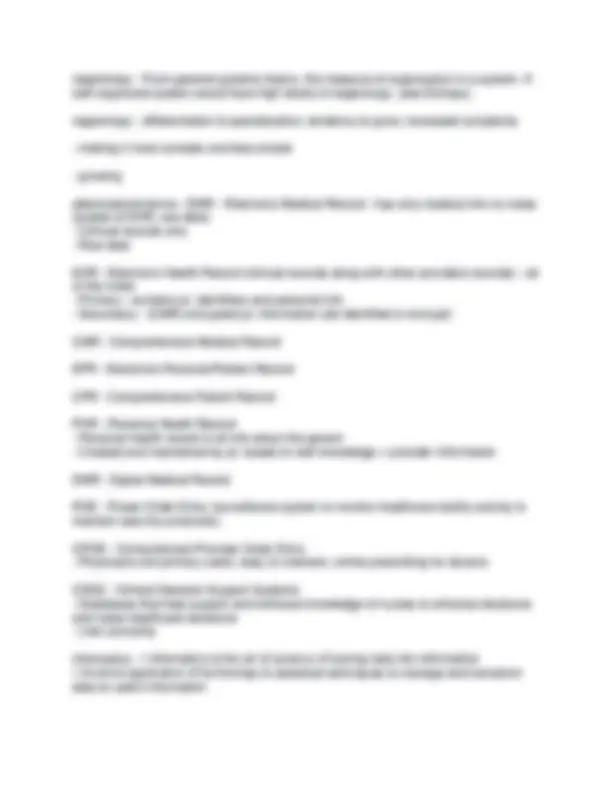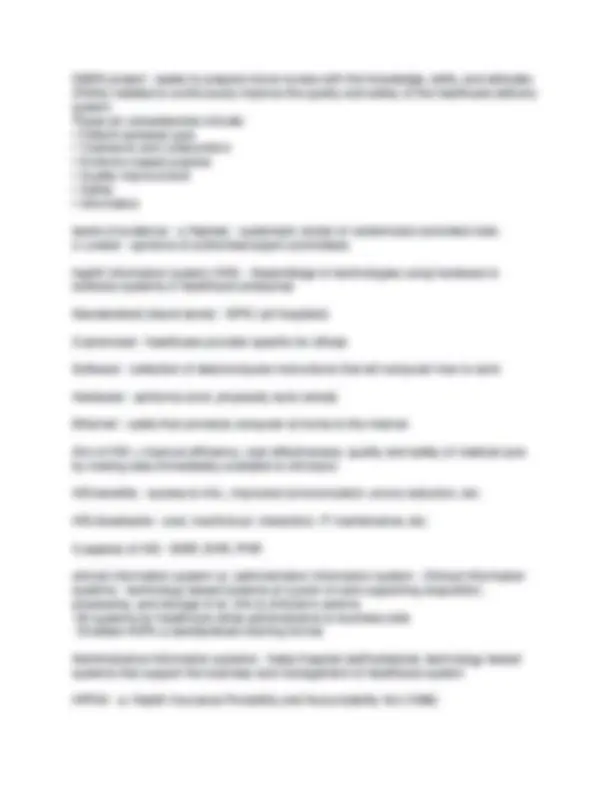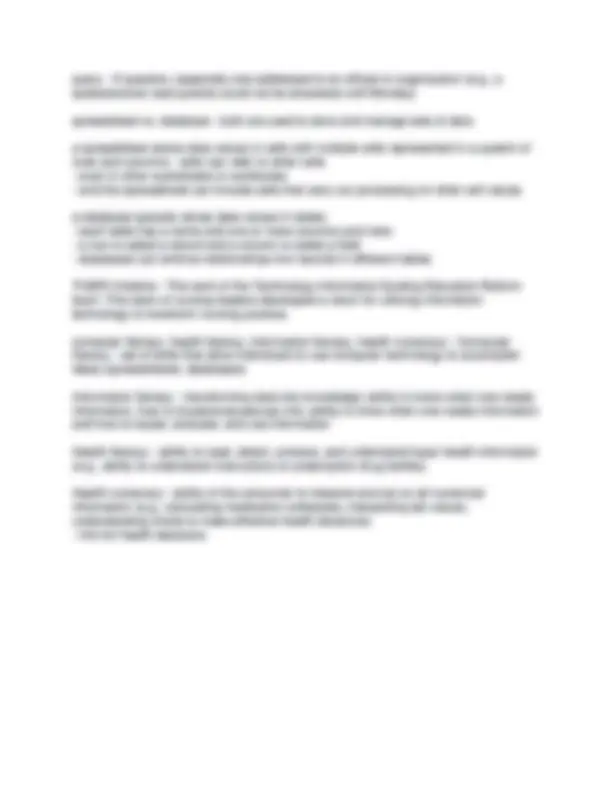Download NR599 Informatics Final Exam and more Exams Advanced Education in PDF only on Docsity!
NR599 Informatics Final Exam
Lewin's Change Theory - A three-step process: unfreezing; moving or change; refreezing
- unfreezing; recognizing a change is needed, change needs to be done d/t safety issue or other concerns
- freezing: change done by motivating, educating, implementing based on showing nurses what is happening isn't the best/show them why they need to change, benefits of change, how they are going to change - makes them more likely to change
- refreezing change is difficult so explain why you need to change and once in place, solidify the practice so they keep doing it PDSA model of quality improvement - Plan, do, study, act
- Plan - identifying there is a problem
- Do - testing and potential solution, testing b/c you aren't sure it's the right solution so do it on a small scale/small test study
- Study - research and analyzing whether or not if it is effective
- Act - implementing change and deciding if we should keep the intervention and if it's meeting the requirements/should we use it
- Continuous model*
- Keep looking at it to see if there are any changes needed and keep evaluating it
- Once you find the right solution you can adapt change based on what you have found as good spreadsheet for nursing - - columns and rows Nursing Primary Use:
- Calculation
- Recalculate for a change in a reference cell (cell in a formula)
- Trending Nursing Concerns
- Quality Tracking
- Medication Errors
- Patient falls
- Hospital Acquired Infections
- Length of stay
- Time & attendance
- Financial /budget mgm
- Some statistics
line graphs for nursing - Line graph - displaying data over time and looking at a trend; evaluating over time and looks at consistency pie chart - Pie chart - percentages, can't look at measured quality outcome over time, time isn't measured by a pie chart rule based error - good rule applied in the wrong situation EHR vs. PHR - EHR - organizational use PHR - personal use CDSS, CPOE and how they are utilized - CDSS - Clinical Decision Support Systems:
- databases that help support and enhance knowledge of nurses to enhance decisions and make healthcare decisions
- like Lexicomp
- gives prompts and reminders to help with implementation of evidence-based practice and can show drug interactions CPOE - computerized provider order entry
- physicians are primary users
- easy to maintain, online prescribing for doctors software, programs, & hardware - software - application within the computer programs - EPIC hardware - actual wires, can touch it - physical component of the computer software - can't touch it (excel program & Microsoft programs, can use but can't see and touch) Standard Nursing Language (SNL) - SNL defines the domain of nursing practice; development has reached a level of applicability for all settings improved quality and safety Data to wisdom continuum - o Data - raw facts, numbers o Information - organized numbers, processing the numbers o Knowledge - looking at how the info is pieced together, converting the information o Wisdom - ability to use and apply that knowledge Donabedian Model - - Nursing care quality - Quality Measure Model
- Process, structure, outcome
- Structure - manner in which care is being delivered (facility, equipment, human resources)
- Pain assessment, intervention, reassessment cycle
- IV infiltration rates
- Psychiatric physical/sexual abuse
- New: restraints, turnover, musculoskeletal injury & others. Nursing Management Minimum Data Set (NMMDS) - provides the data needed by nurse managers and administrators in making decisions about care management. NMMDS is designed to complement the clinical patient-oriented data designated the NMDS and is registered with HL7 and mapped to SNOMED. i.e. staffing decisions are important and may relate to all of the items below on this nursing minimum data set Minimum set data - data bare minimum collected on a pt.
- Name, DOB, etc. information literacy - the ability to figure out the type of information you need, find that information, evaluate it, and properly use it Nursing Informatics - specialty that integrates nursing science, computer science, and information science to manage and communicate data, information, and knowledge in nursing practice Aggregated data - data from more than one source and grouped for comparison
- Data from multiple sources
- One thing from multiple sources
- E.g., # of pt. fall in hospitals - just looking at falls but from different sources HITECH Act of 2009 - - Provided incentive payments to hospitals and healthcare providers to adopt health IT.
- "Meaningful Use"- criteria required to be met that demonstrated meaningful use of electronic health records (EHR). EHR technology must be used to achieve certain objectives. made into a law to promote the adoption and meaningful use of health information technology 21st Century Cures Act 2016 - •Created new clinical trial design options and accelerated pathways for drug approval for serious or life-threatening disease •Opponents fear drugs approvals through this process will endanger public safety •Provided funding to National Institute of Health for medical research
This Act was passed in large part to streamline and add flexibility and innovation to the drug development and approval process, primarily by creating new clinical trial design options and by accelerating the pathways to market for drugs intended to treat certain serious or life threatening diseases. This law also provides for billions of dollars of additional funding to the National Institute of Health (NIH). why evaluate online health information: - uncertain quality:
- 1/10 health information sites r/t specific dx contain wrong info rapid proliferation of health info sites:
- there are no standard rules to apply for information to be published on web why is there a push toward consumer-centric health care paradigm? - - rise on cost of healthcare
- baby-boomer cohort - > retirement
- current system rooted in in knowledge relationship between providers & pt.'s health literacy - degree to which individual have capacity to obtain, process & understand basic health info & services needed to make appropriate health decisions emphasize people's ability to use health info rather than just understand it skills:
- evaluating health info (credibility, quality)
- analyzing risks and benefits
- locating health info
- decision making skills
- computer/search skills health numeracy - ability of a consumer to understand, interpret and act on numerical information
- calculating dosages
- interpreting test results
- articulating health concerns
- describing hx and symptoms accurately
- ask relevant questions
- understand med and txmt directions assessing pt.'s health literacy/numeracy: - Assess pt.'s:
- cognitive, physical, psychosocial resources Assess pt.'s self-management
cyberchondriac - person who compulsively searches online for information about real or imagined symptoms of illness
- person obsessive about illness
- believe this is a healthful strategy
- misdiagnosis self
- fear they have afflictions
- pt. getting info on web, don't discuss with provider, make decisions based on info. web page considerations - - screen readers features
- navigations bars
- features of web page may trigger user effects
- color blindness
- visual impairment
- photosensitive epilepsy seizure triggers (light to dark) guidelines for evaluating web health information: - - source (author, credentials, web sponsor)
- validity & quality (purpose, scholarly resources, accuracy, currency, peer review, bias)
- privacy (HON quality taing, use of recognized privacy standards)
- funding (non-for-profit vs commercial interests) telehealth - Use of technology to deliver health-related services and information, including telemedicine AIM: to increase access to healthcare to improve health outcomes through assistance of technology to overcome geographic barriers to reduce cost of healthcare Examples:
- blood pressure, weight, pulse, oxygen level guidelines for nurses/clinicians for health literacy research: - - not blame individual for not understanding info not made clear
- everyone is at risk for misunderstanding info if the topic is emotionally charged/complex
- pt.'s may be embarrassed to ask questions
- misleading ads and gimmicks
- additional challenges in understanding how to select insurance plans and benefits (especially if never insured) associated health literacy factors: - - ability to read and comprehend (prescription bottles, appointment instructions)
- ability to take responsibility for health
- lack access to accurate and quality info
- poor vision, hearing difficulties
- reading level self management - tasks:
- medical management
- role management
- emotional management skill:
- problem solving
- decision making
- resource utilization
- formation of patient-provider partnership
- action planning
- self tailoring personal health record (PHR) - collection of information about an individual's health care such as medications (prescriptions and over the counter drugs), hospitalizations, doctor visits, allergies and other medical conditions that can be stored as long as he or she chooses PHR tools allow the individual to look up info about their own meds and conditions to manage their own health by providing tips on eating right, skin protection, etc. ending of URLs: - .com - commercial, often companies that make money .edu - education institution, often universities .gov - government, usually federal, state, and local .net - network, could be any site .org - organization, most often a nonprofit nurses and telecommunication: - - health coaching
- nurse navigation/care coordination
- telephone triage
- calling pt.'s families
- insurance case management
•Information processing capacity and memory capacity of humans. (See Theory Lecture) •Cognitive theories are of concern related to the complexity of technology and the human machine interaction. •There is need to be concerned about the amount a person can absorb and utilize constructively. Human Machine Impact - Human-machine usability issues often result in:
- INCREASING ERRORS
- DRASTIC CONSEQUENCES
- Decreased efficiency
- Decreased productivity
- Underutilization
- Overt/Covert Resistance
- Yet goal is the opposite. slip error - understanding of situation is correct & intention to respond is correct but wrong action accidentally is triggered lapse error - failure to carry out recognized action (forgetting, not realizing) Usability Theory - represents a multidimensional concept that involves users' evaluation of several measures, each one representative of their effectiveness in performing a task users' satisfaction with their own ability to achieve the goal through use of the system involves the ease of use, users' satisfaction that they have achieved their goals, and aesthetics of the technology usability tests - tests checking requirements about the user interface; It specifically involves evaluators examining the interface and judging its compliance with recognized usability principles (the "heuristics") •Determining Needs requirements •Exploratory tests •Comparison Tests •Validation Tests •Task Analyses
Counter-Measures - actions, processes, devices, or systems that can prevent, or mitigate the effects of, threats to a computer, server, or network Job Aids:
- references, task lists, decrease reliance on memory Safety Systems:
- Interlock (lock out till sequence is done)
- Lock In (hold until second action verified - i.e. saving on computer)
- Lock Out (keeps person out until action taken - i.e. passwords) Ergonomics Enhancement Preventing Negative Outcomes on Users - •Repetitive stress injury
- Carpel Tunnel from median nerve compression in wrist
- Rests & keyboard adaptations have not sig. decreased injury. •Eyestrain •Backstrain/Prolonged sitting User-Centered Design (UCD) - Design methodology in which interviews and empirical tests of users needs determine the characteristics of a design or computer application process outlines the phases throughout a design and development life-cycle all while focusing on gaining a deep understanding of who will be using the product
- specify the context of use
- specify requirements
- create design solutions
- evaluate designs Technological Determinism - •Humans have little choice or control •Technological innovation is inevitable •Technology is the cause of basic changes in society and interaction •Civilization is constructed of "technique" automatism, standardization & universalism. (Ellul, 1964) Technological Neutrality - •Technology is neither good nor bad in and of itself •Technologies are merely aids to human activity •Effect of technology depends on human use of the device Social Determinism of Technology - •Technology is a product of culture •Technology does not matter itself •Technology is a product of the social and culture of its development
benchmarks - Permanent reference marks or points established for use by surveyors in measuring differences in elevation. boolean operators - Boolean Operators - AND, OR, and NOT used in search strings to refine the scope of search AND - requires both terms in returned document (narrows seach, requires both) OR - either term or both in returned document - widens b/c it has one word or not the other NOT - narrows the search, excludes words to narrow down the search Parenthesis () - customize results to reflect topic more accurately Truncation - use of symbols/letters to search variations in word forms & allows retrieval of different character combinations (e.g., H#emtology = hematology or haematology); common wildcard symbols are *, $, #,?
- Broadens search Quotation marks - exactly in the quotations
- Narrows it reverberation - effect of change within 1 part of a system on other parts, intended or unintended consequences equifinality - one symptom can have many causes ability to reach the same end state from different initial states by different means same outcome entropy - a measure of the disorder of a system disorganization/randomness; tendency to break down into simplest parts, loss of data/info, simplicity broken down into simplest parts which is the only way to use that information because it's so disorganized breaking down dynamic hemostasis - tendency to maintain balance/steady state; regulated by feedback loop
negentropy - From general systems theory, the measure of organization in a system. A well-organized system would have high levels of negentropy. (see Entropy). negentropy - differentiation & specialization, tendency to grow, increased complexity
- making it more complex and less simple
- growing abbreviations/terms - EMR - Electronic Medical Record - has only medical info no notes (subset of EHR, raw data)
- Clinical records only
- Raw data EHR - Electronic Health Record (clinical records along with other providers records) - all of the notes
- Primary - contains pt. identifiers and personal info
- Secondary - (CMR) encrypted pt. information (de-identified or encrypt) CMR - Comprehensive Medical Record EPR - Electronic Personal/Patient Record CPR - Comprehensive Patient Record PHR - Personal Health Record
- Personal health record is all info about the person
- Created and maintained by pt. based on self-knowledge + provider information DMR - Digital Medical Record POE - Power Order Entry (surveillance system to monitor healthcare facility activity to maintain security protocols); CPOE - Computerized Provider Order Entry
- Physicians are primary users, easy to maintain, online prescribing for doctors CDSS - Clinical Decision Support Systems
- Databases that help support and enhance knowledge of nurses to enhance decisions and make healthcare decisions
- Like Lexicomp informatics - • Informatics is the art of science of turning data into information
- Involves application of technology & statistical techniques to manage and transform data to useful information
b. Privacy between insurance and physicians c. Ensured portability of health insurance, protection of personal health information (PHI) and ensures identifiable info must be private and secure d. Mandates pt. access to healthcare records e. HIPAA and HITECH acts aim to assure a secure way of sharing private health data in any electronic data HITECH terms to know: - Meaningful use - has to have a meaningful reason to share, make sure data is being shared between healthcare providers in the correct format/channel/and at the right time
- Needs to be shared with correct people, channel, and right time Interoperability - for when you need to file something with Medicare/Medicaid; must meet certain standards to share than information with them
- Meet certain standards, specification and certification of EHR technology to SHARE the information and data open vs. closed systems - Open systems - have external interactions (e.g., pt. care unit is a system of providing care and there are many aspects of that unit that incorporate input processes and output à open system b/c it has interactions outside the hospital)
- Ability to communicate freely (mychart) Closed systems - self-contained and no interactions within environment of that system (e.g., IV tubing, when only employees have access to the record)
- Certain info is hidden for privacy (most of healthcare) classic conditioning (pavlov) - i. unlearned response that we can't control - unconditional stimulus elicits unconditioned response (e.g., food automatically elicits salivation) ii. learned response - conditioned stimulus elicits conditioned response (e.g., smell of food elicits salivation, hungry when you smell the food and remember it) operant conditioning (skinner) - i. Behaviors dependent on reinforcements ii. Positive reinforcement - adding pleasant consequences to increase behavior iii. Negative reinforcement - removing unpleasant consequence to increase behavior (silence IV pump beeping) iv. Punishment (opposite of reinforcement) - action to stop behavior (e.g., spanking) v. Extinction - action to decrease behavior by no action (e.g., ignoring behavior) 3 stages of memory according to Klar - Klar - Information moves through components of the mind in an organized way 3 stages:
ii. Sensory memory - brief, no time for storage, if not paying attention to it you'll forget iii. Short-term or Working memory - holds temporary info, will get lost without reinforcement iv. Long-term memory - can lose it over time still situative learning theory - Situative Learning Theory - effective education requires practice (e.g., clinical experiences at Capital for nursing students) In settings that situations that would normally involve that knowledge Engaging in increasingly more complex tasks within social communities More opportunities for practice = better competence of the skill, learning from others to become an expert Activity Theory - Activity Theory - considers an entire work/activity system (including teams, organizations, etc.) beyond just one actor or user i. Bridges gap between individual subject and social reality ii. Identifies activities or actions that a person takes using an object iii. Fundamental aspect for understanding the human-error relationship iv. Accounts for - environment, hx of person, culture, role of the artifact, motivations, and complexity of real-life activity Individual Change: Stages of Change Model (Prochastka) - Indicates change comes 1st with contemplation and when a person is ready to change
- Precontemplation - thinking about change
- Contemplation
- Ready to change - how to change
- Maintenance
- Permanent change
- Relapse That person develops maintenance and behaviors Eventually permanent change E.g., stopping smoking à only when a person is ready to stop smoking will that person be able to stop

